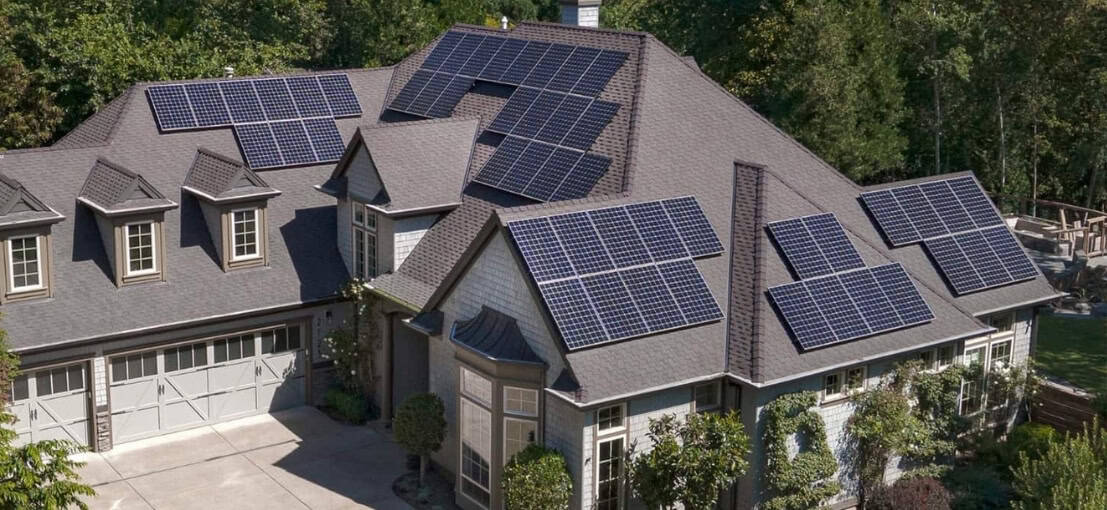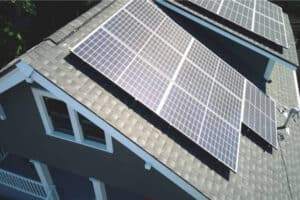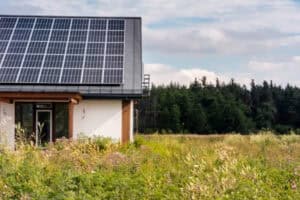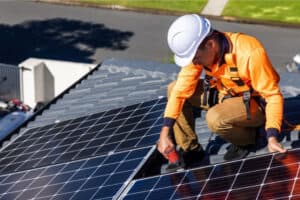
Exteriors
|Sustainability
The Pros and Cons of Grid-Tied vs. Off-Grid Solar in the Pacific Northwest
When researching options for solar systems in the Pacific Northwest, homeowners are faced with two main options: grid-tied and off-grid. There are advantages and disadvantages for each, depending on your specific residential solar needs. Let’s dive in to see which system is right for you.
What Is A Grid-Tied Solar System? 
Grid-tied solar systems are the most popular for both residential and business use. Also called on-grid or grid-feed, they are connected to your local utility grid and work with the existing power supply in your home to deliver as much energy as possible. Their intelligent design allows them to know when power is available and when it’s not, easily switching between grid power and solar power delivery.
Grid-Tied Solar System Components:
- Grid-tie inverter (GTI) or microinverters
- Power meter
Grid-tied solar panels collect sunlight and turn it into direct current (DC). The inverter turns DC into alternating current (AC), which powers your appliances by running through a switchboard. From there, the power meter keeps track of the electricity generated by the grid and by your solar system. Any time your solar panels aren’t generating enough electricity to meet your home’s demand, like during nighttime or cloudy days, it switches back to its grid power source. In this case, it’s not necessary to purchase a battery backup system to store excess energy, which makes grid-tied systems the more affordable option.
What Is An Off-Grid Solar System?
Like the name suggests, off-grid solar systems are ideal for those who live in remote areas or don’t want to rely on their local utility grid. This type of system relies solely on sunlight as its main source of energy, making it completely self-sufficient, but also more expensive due to its complexity.
Off-grid systems work by taking the energy generated from solar panels and using it to charge a solar battery via a charge controller. The charge controller helps regulate the electricity in the battery bank to keep it from overcharging, which can cause damage to the system. The electricity is then converted into AC by using an off-grid inverter.
The battery bank allows your home to run exclusively on solar, even during nighttime or overcast days. For homeowners in the Pacific Northwest, extra battery banks or a backup generator may be needed to prepare for consecutive days without sun exposure.
Off-Grid Solar System Components:
- Solar charge controller
- Battery bank
- Off-grid inverter
- DC disconnect (additional)
- Backup generator (optional)
Is it Better to Have Solar Panels On-Grid or Off-Grid?
Let’s look at a few pros and cons of on- and off-grid solar panels.
Pros of Grid-Tied Solar Panels
- Low upfront costs: Grid-tied panels have the lowest total costs to install.
- Net metering participation: Excess electricity produced by your panels can lower your monthly energy bills and is mandatory in 35 states.
- Access to grid power: Your home doesn’t have to rely on solar alone; utility power is available as needed.
- Less equipment is needed.
Cons of Grid-Tied Solar Panels
- No power during outages (unless you have a battery).
Pros of Off-Grid Solar Panels
- Energy independence: Off-grid panels are suitable for remote locations.
- No grid influences: Off-grid solar panels are not affected by fluctuations in energy prices and will keep working during outages.
Cons of Off-Grid Solar Panels
- Higher upfront costs: You’ll pay more during the setup of off-grid panels.
- Limited by battery capacity: Extra battery banks are typically necessary for off-grid systems.
- Requires lifestyle changes: Homeowners will need to monitor their energy consumption to ensure they have the electricity they need.
The Ideal Setup for Each Residential Solar System
Grid-tied panels are best for homeowners with access to full retail net metering and who don’t have frequent power outages in their area.
If you don’t have grid access in your area and are equipped to handle the lifestyle and expenses associated with it, off-grid solar will be ideal for your situation.
Get Started On Your Home Solar System With Neil Kelly Solar
Neil Kelly’s seasoned solar energy professionals have the resources and expertise to tailor a system to your home’s unique requirements. We’ll help evaluate the solar energy system potential of your building or space and assess tax credits and incentives that can offset the cost of installing the system in many areas.
Schedule your complimentary 30-minute assessment via phone or video with a Neil Kelly Solar consultant today.